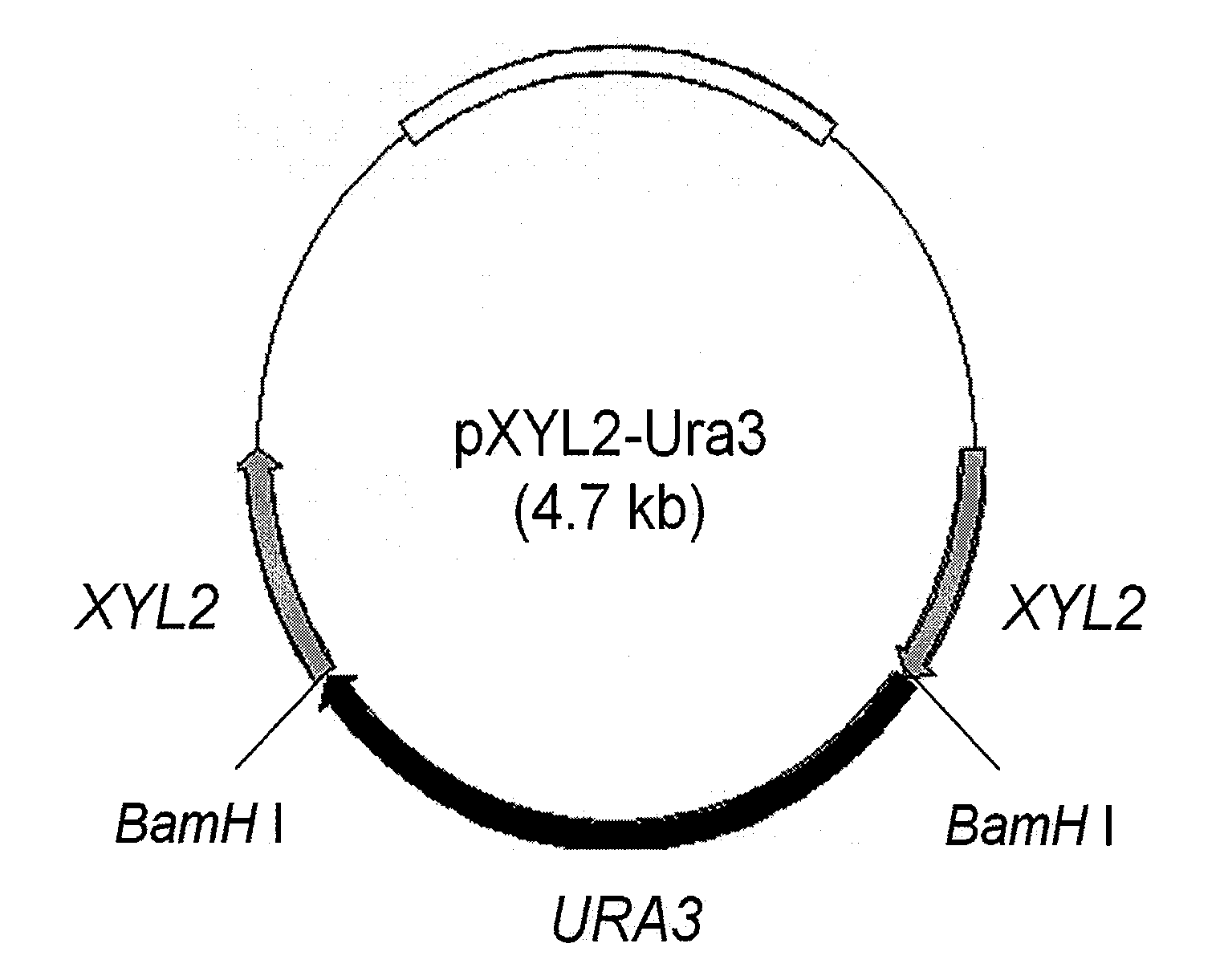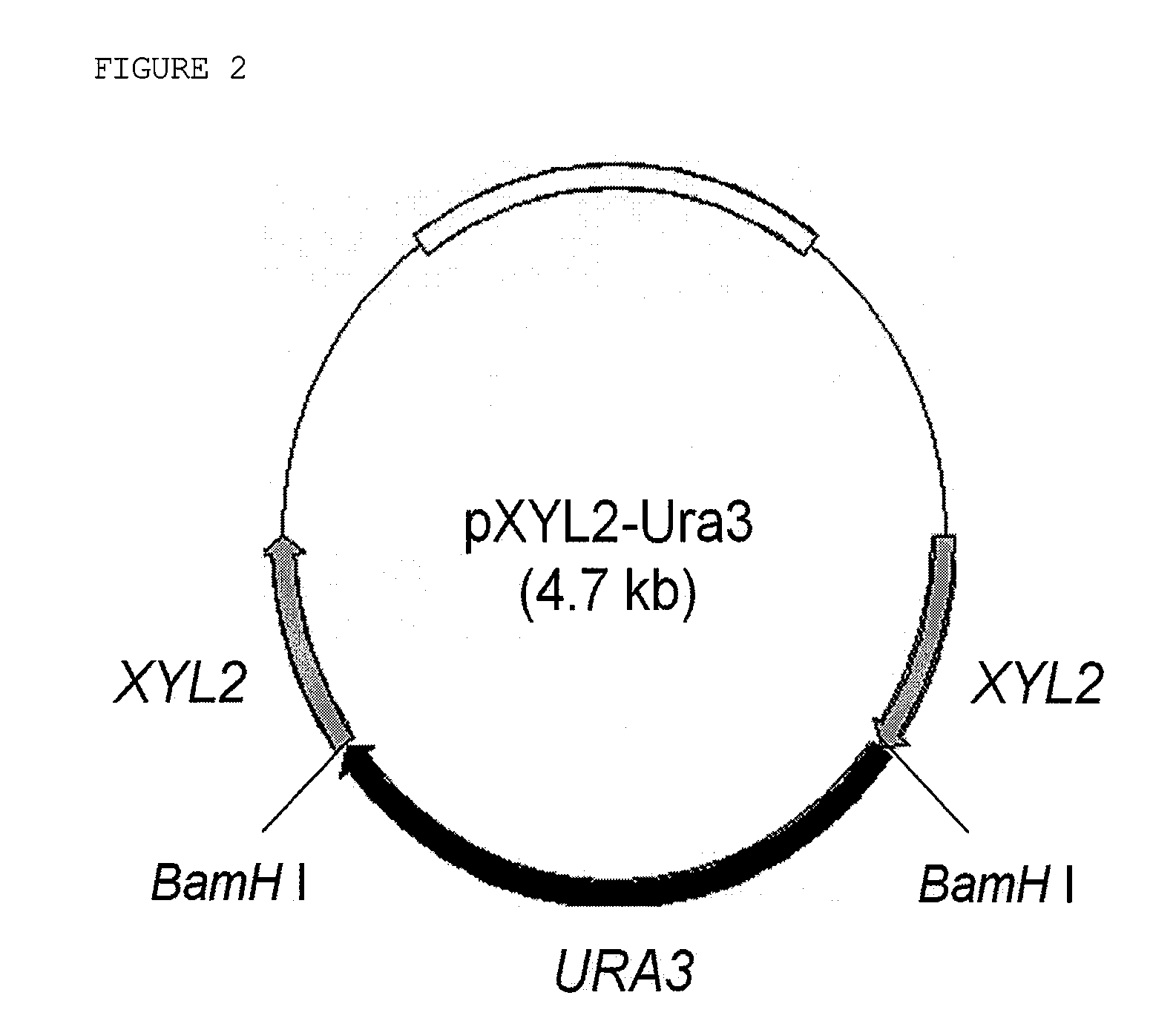Xylitol dehydrogenase-inactivated and arabinose reductase-inhibited mutant of candida tropicalis, method of producing high-yield of xylitol using the same, and xylitol produced thereby
a technology of xylitol and arabinose, which is applied in the field of xylitol dehydrogenaseinactivated and arabinose reductase-inhibited mutant of candida tropicalis, and produces a high yield of xylitol. it can solve the problems of low yield of xylitol, high cost, and inability to extract xylitol from fruits or vegetables. it achieves a high yield of x
- Summary
- Abstract
- Description
- Claims
- Application Information
AI Technical Summary
Benefits of technology
Problems solved by technology
Method used
Image
Examples
example 1
[0044]To clone unknown Candida tropicalis xylitol dehydrogenase gene, the gene homology between already known Pichia stipitis xylitol dehydrogenase and genes belonging to the medium-chain alcohol dehydrogenase family, including sorbitol dehydrogenase, alcohol dehydrogenase and threonine dehydrogenase, was investigated. Using the resulting highly conserved region as a template, PCR was performed using the following primers (SEQ ID NO: 1 and SEQ IN NO: 2) in the following conditions to obtain a 1,095-bp Candida tropicalis xylitol dehydrogenase gene: 1 min at 94 □, 25 cycles of 30 sec at 94 □, 30 sec at 58 □ and 30 sec at 72 □, and 3 min at 72 □. The amplified Candida tropicalis xylitol dehydrogenase gene was cloned into a pGEM-T easy vector (BIONEX, Korea), a BamHI site was introduced into the middle of the xylitol dehydrogenase gene, and an ura3 gene was introduced into the introduced BamHI site, thus obtaining a 4.7-kb pXYL2-Ura3 transformation vector as shown in FIG. 2.
[0045]primer...
example 2
[0050]The effects of medium aeration and oxygen transfer rate on xylitol yield and productivity in the production of xylitol using the xylitol dehydrogenase-inactivated mutant of Candida tropicalis BS-xdh1 were investigated.
[0051]The xylitol dehydrogenase-inactivated mutant of Candida tropicalis BS-xdh1 was inoculated in 3 ml of YM medium (20 g / L glucose, 3 g / L yeast extract, 3 g / L malt extract, and 5 g / L bacto-peptone) and cultured in a shaking incubator at 30 □ and 200 rpm for 12 hours. Then, 1 ml of the culture medium was inoculated in 50 ml of YM medium and cultured in a shaking incubator at 30 □ and 200 rpm for 12 hours.
[0052]Then, 50 ml of the culture medium was inoculated in a fermenter containing 1 liter of a xylitol-producing medium (50 g / L xylose, 20 g / L glycerol, 10 g / L yeast extract, 5 g / L KH2PO4 and 0.2 g / L MgSO4.7H2O, pH 4.5) and cultured at for 24 hours with agitation at 300, 400 and 500 rpm, and the changes in dry cell weight, xylose, glycerol and xylitol concentrati...
example 3
[0056]Xylitol was produced using a corncob hydrolyzate as a substrate.
[0057]The xylitol dehydrogenase-inactivated mutant of Candida tropicalis BS-xdh1 was cultured in the same conditions as in Example 2, and 50 ml of the culture medium was inoculated in a fermenter containing 1.0 liter of a xylitol-producing medium (100 g / L xylose, 6.6 g / L glucose, 13.4 g / L arabinose, 30 g / L glycerol, 10 g / L yeast extract, 5 g / L KH2PO4 and 0.2 g / L MgSO4.7H2O, pH 4.5) including a corncob hydrolyzate (83.5% xylose, 5.3% glucose and 11.2% arabinose) and was cultured at 30 □ for 30 hours with agitation at 500 rpm. Then, the changes in dry cell weight and xylose, glucose, arabinose, arabitol, glycerol and xylitol concentrations with the passage of time were measured. The measurement of dry cell weight and xylose, glucose, arabinose, arabitol, glycerol and xylitol concentrations was carried out in the same manner as described in Example 2. The measurement results are shown in Table 2 below.
TABLE 2Results ...
PUM
| Property | Measurement | Unit |
|---|---|---|
| concentration | aaaaa | aaaaa |
| concentration | aaaaa | aaaaa |
| pH | aaaaa | aaaaa |
Abstract
Description
Claims
Application Information
 Login to View More
Login to View More - R&D
- Intellectual Property
- Life Sciences
- Materials
- Tech Scout
- Unparalleled Data Quality
- Higher Quality Content
- 60% Fewer Hallucinations
Browse by: Latest US Patents, China's latest patents, Technical Efficacy Thesaurus, Application Domain, Technology Topic, Popular Technical Reports.
© 2025 PatSnap. All rights reserved.Legal|Privacy policy|Modern Slavery Act Transparency Statement|Sitemap|About US| Contact US: help@patsnap.com



